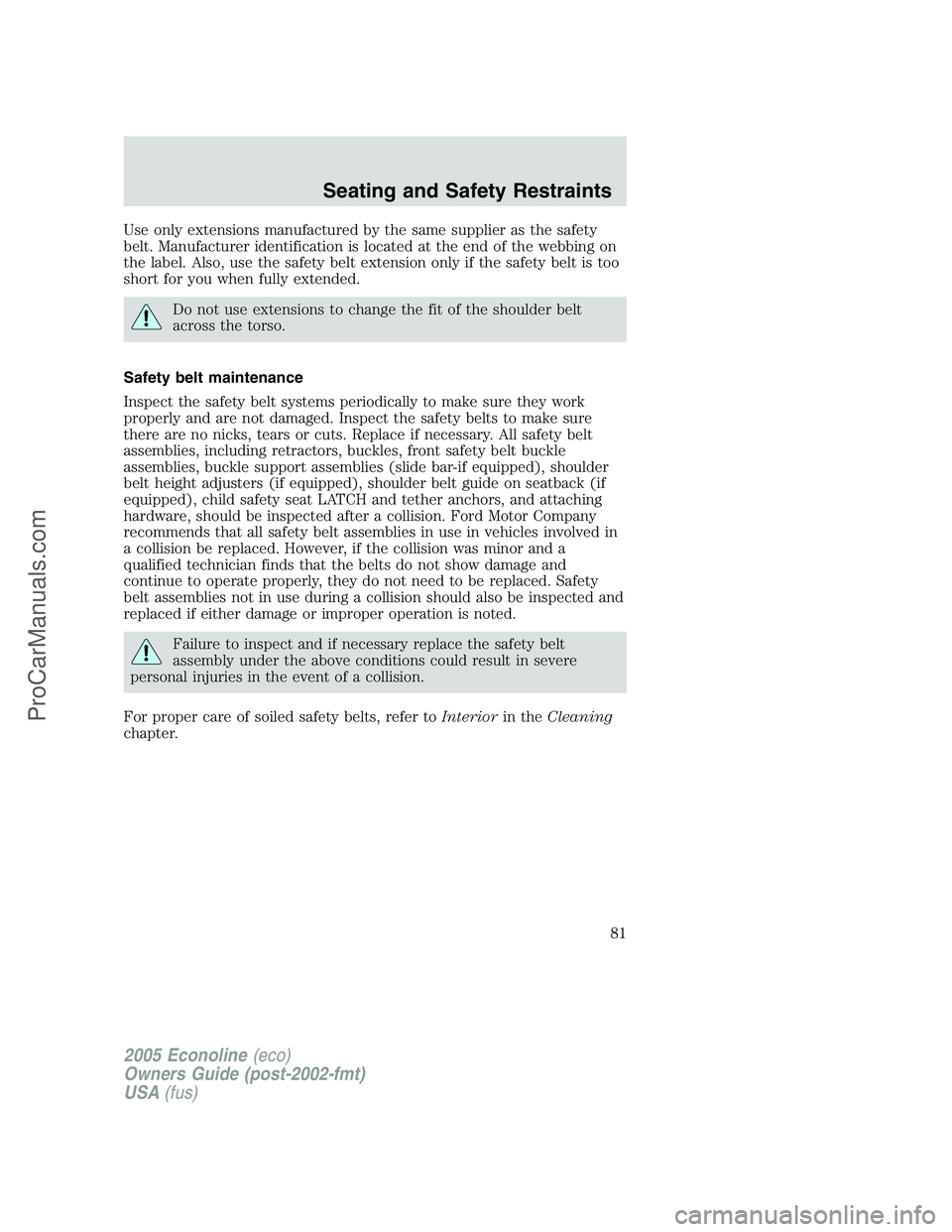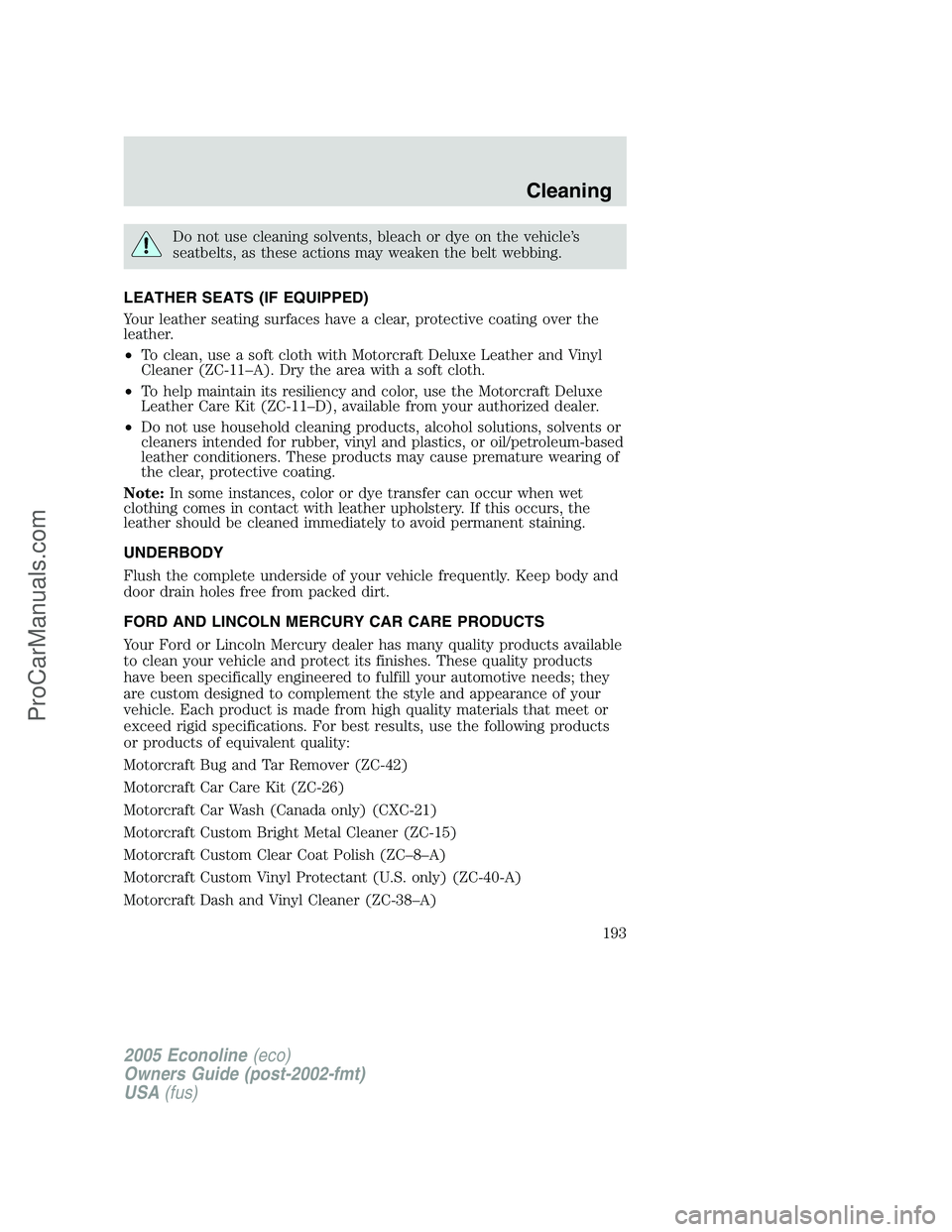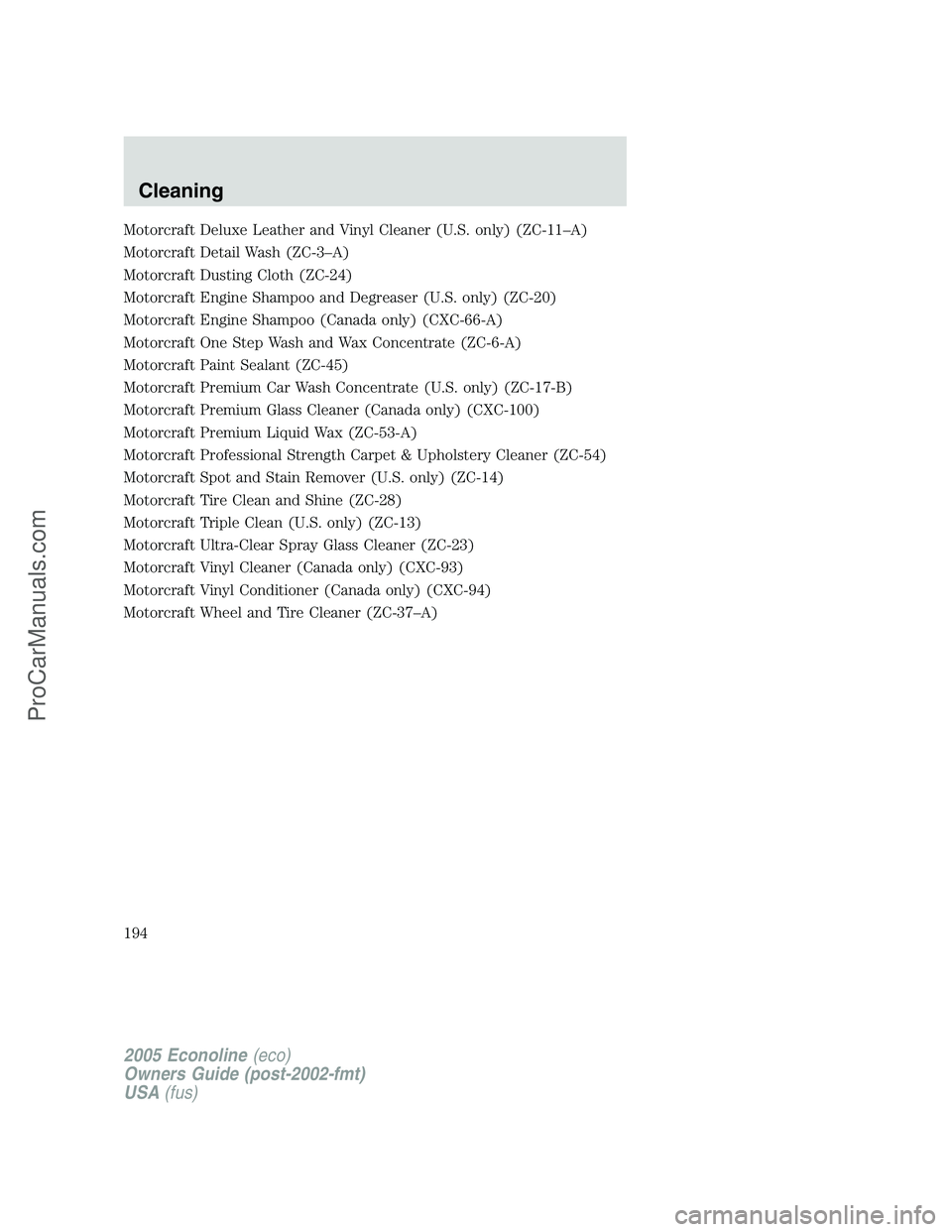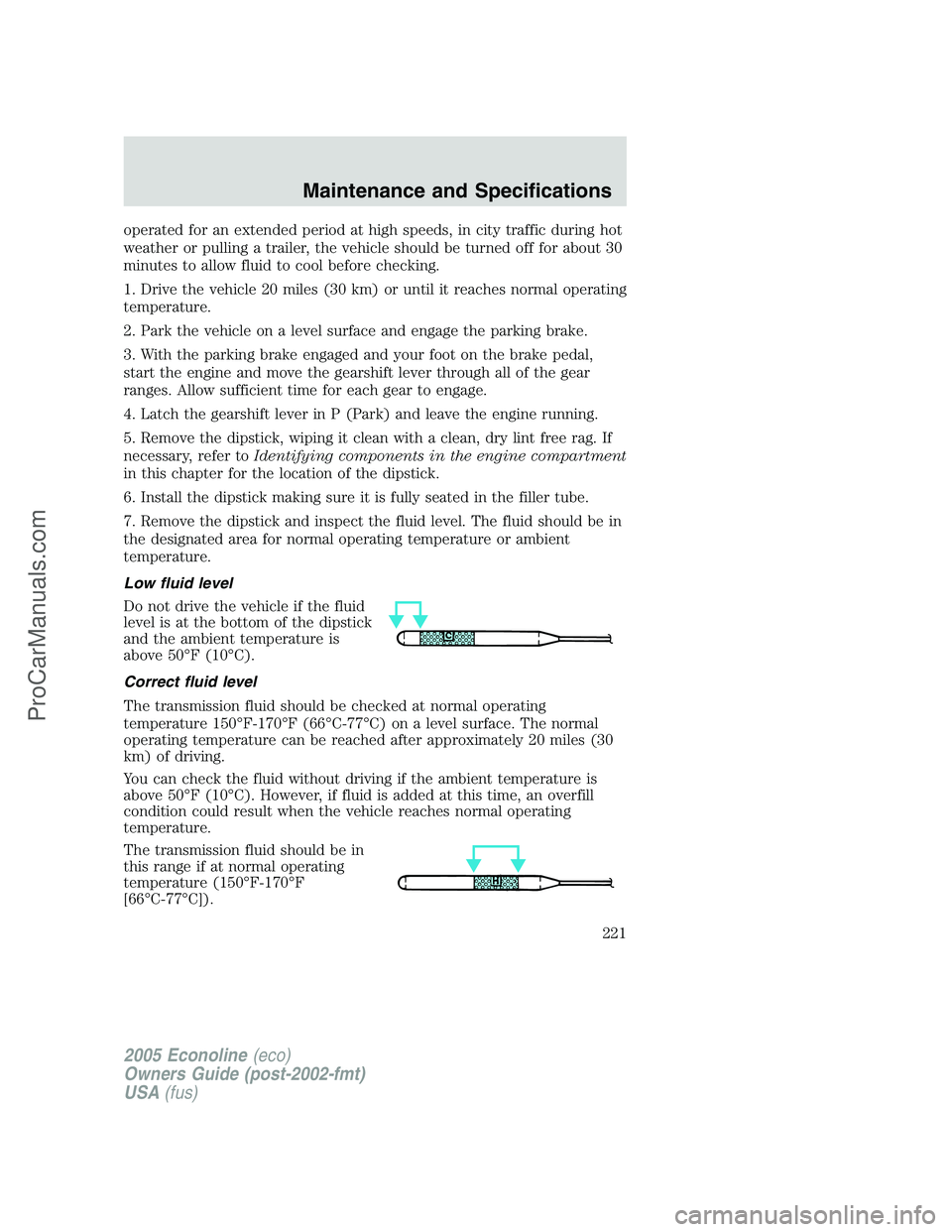2005 FORD E-450 Lean condition
[x] Cancel search: Lean conditionPage 81 of 248

Use only extensions manufactured by the same supplier as the safety
belt. Manufacturer identification is located at the end of the webbing on
the label. Also, use the safety belt extension only if the safety belt is too
short for you when fully extended.
Do not use extensions to change the fit of the shoulder belt
across the torso.
Safety belt maintenance
Inspect the safety belt systems periodically to make sure they work
properly and are not damaged. Inspect the safety belts to make sure
there are no nicks, tears or cuts. Replace if necessary. All safety belt
assemblies, including retractors, buckles, front safety belt buckle
assemblies, buckle support assemblies (slide bar-if equipped), shoulder
belt height adjusters (if equipped), shoulder belt guide on seatback (if
equipped), child safety seat LATCH and tether anchors, and attaching
hardware, should be inspected after a collision. Ford Motor Company
recommends that all safety belt assemblies in use in vehicles involved in
a collision be replaced. However, if the collision was minor and a
qualified technician finds that the belts do not show damage and
continue to operate properly, they do not need to be replaced. Safety
belt assemblies not in use during a collision should also be inspected and
replaced if either damage or improper operation is noted.
Failure to inspect and if necessary replace the safety belt
assembly under the above conditions could result in severe
personal injuries in the event of a collision.
For proper care of soiled safety belts, refer toInteriorin theCleaning
chapter.
2005 Econoline(eco)
Owners Guide (post-2002-fmt)
USA(fus)
Seating and Safety Restraints
81
ProCarManuals.com
Page 193 of 248

Do not use cleaning solvents, bleach or dye on the vehicle’s
seatbelts, as these actions may weaken the belt webbing.
LEATHER SEATS (IF EQUIPPED)
Your leather seating surfaces have a clear, protective coating over the
leather.
•To clean, use a soft cloth with Motorcraft Deluxe Leather and Vinyl
Cleaner (ZC-11–A). Dry the area with a soft cloth.
•To help maintain its resiliency and color, use the Motorcraft Deluxe
Leather Care Kit (ZC-11–D), available from your authorized dealer.
•Do not use household cleaning products, alcohol solutions, solvents or
cleaners intended for rubber, vinyl and plastics, or oil/petroleum-based
leather conditioners. These products may cause premature wearing of
the clear, protective coating.
Note:In some instances, color or dye transfer can occur when wet
clothing comes in contact with leather upholstery. If this occurs, the
leather should be cleaned immediately to avoid permanent staining.
UNDERBODY
Flush the complete underside of your vehicle frequently. Keep body and
door drain holes free from packed dirt.
FORD AND LINCOLN MERCURY CAR CARE PRODUCTS
Your Ford or Lincoln Mercury dealer has many quality products available
to clean your vehicle and protect its finishes. These quality products
have been specifically engineered to fulfill your automotive needs; they
are custom designed to complement the style and appearance of your
vehicle. Each product is made from high quality materials that meet or
exceed rigid specifications. For best results, use the following products
or products of equivalent quality:
Motorcraft Bug and Tar Remover (ZC-42)
Motorcraft Car Care Kit (ZC-26)
Motorcraft Car Wash (Canada only) (CXC-21)
Motorcraft Custom Bright Metal Cleaner (ZC-15)
Motorcraft Custom Clear Coat Polish (ZC–8–A)
Motorcraft Custom Vinyl Protectant (U.S. only) (ZC-40-A)
Motorcraft Dash and Vinyl Cleaner (ZC-38–A)
2005 Econoline(eco)
Owners Guide (post-2002-fmt)
USA(fus)
Cleaning
193
ProCarManuals.com
Page 194 of 248

Motorcraft Deluxe Leather and Vinyl Cleaner (U.S. only) (ZC-11–A)
Motorcraft Detail Wash (ZC-3–A)
Motorcraft Dusting Cloth (ZC-24)
Motorcraft Engine Shampoo and Degreaser (U.S. only) (ZC-20)
Motorcraft Engine Shampoo (Canada only) (CXC-66-A)
Motorcraft One Step Wash and Wax Concentrate (ZC-6-A)
Motorcraft Paint Sealant (ZC-45)
Motorcraft Premium Car Wash Concentrate (U.S. only) (ZC-17-B)
Motorcraft Premium Glass Cleaner (Canada only) (CXC-100)
Motorcraft Premium Liquid Wax (ZC-53-A)
Motorcraft Professional Strength Carpet & Upholstery Cleaner (ZC-54)
Motorcraft Spot and Stain Remover (U.S. only) (ZC-14)
Motorcraft Tire Clean and Shine (ZC-28)
Motorcraft Triple Clean (U.S. only) (ZC-13)
Motorcraft Ultra-Clear Spray Glass Cleaner (ZC-23)
Motorcraft Vinyl Cleaner (Canada only) (CXC-93)
Motorcraft Vinyl Conditioner (Canada only) (CXC-94)
Motorcraft Wheel and Tire Cleaner (ZC-37–A)
2005 Econoline(eco)
Owners Guide (post-2002-fmt)
USA(fus)
Cleaning
194
ProCarManuals.com
Page 221 of 248

operated for an extended period at high speeds, in city traffic during hot
weather or pulling a trailer, the vehicle should be turned off for about 30
minutes to allow fluid to cool before checking.
1. Drive the vehicle 20 miles (30 km) or until it reaches normal operating
temperature.
2. Park the vehicle on a level surface and engage the parking brake.
3. With the parking brake engaged and your foot on the brake pedal,
start the engine and move the gearshift lever through all of the gear
ranges. Allow sufficient time for each gear to engage.
4. Latch the gearshift lever in P (Park) and leave the engine running.
5. Remove the dipstick, wiping it clean with a clean, dry lint free rag. If
necessary, refer toIdentifying components in the engine compartment
in this chapter for the location of the dipstick.
6. Install the dipstick making sure it is fully seated in the filler tube.
7. Remove the dipstick and inspect the fluid level. The fluid should be in
the designated area for normal operating temperature or ambient
temperature.
Low fluid level
Do not drive the vehicle if the fluid
level is at the bottom of the dipstick
and the ambient temperature is
above 50°F (10°C).
Correct fluid level
The transmission fluid should be checked at normal operating
temperature 150°F-170°F (66°C-77°C) on a level surface. The normal
operating temperature can be reached after approximately 20 miles (30
km) of driving.
You can check the fluid without driving if the ambient temperature is
above 50°F (10°C). However, if fluid is added at this time, an overfill
condition could result when the vehicle reaches normal operating
temperature.
The transmission fluid should be in
this range if at normal operating
temperature (150°F-170°F
[66°C-77°C]).
2005 Econoline(eco)
Owners Guide (post-2002-fmt)
USA(fus)
Maintenance and Specifications
221
ProCarManuals.com
Page 222 of 248
![FORD E-450 2005 Owners Manual The transmission fluid should be in
this range if at ambient temperature
(50°F-95°F [10°C-35°C]).
High fluid level
Fluid levels above the safe range
may result in transmission failure.
An overfill FORD E-450 2005 Owners Manual The transmission fluid should be in
this range if at ambient temperature
(50°F-95°F [10°C-35°C]).
High fluid level
Fluid levels above the safe range
may result in transmission failure.
An overfill](/manual-img/11/57790/w960_57790-221.png)
The transmission fluid should be in
this range if at ambient temperature
(50°F-95°F [10°C-35°C]).
High fluid level
Fluid levels above the safe range
may result in transmission failure.
An overfill condition of transmission
fluid may cause shift and/or
engagement concerns and/or possible damage.
High fluid levels can be caused by an overheating condition.
Adjusting automatic transmission fluid levels
Before adding any fluid, make sure the correct type is used. The type of
fluid used is normally indicated on the dipstick and also in the
Lubricant specificationssection in this chapter.
Use of a non-approved automatic transmission fluid may cause
internal transmission component damage.
If necessary, add fluid in 1/2 pint (250 ml) increments through the filler
tube until the level is correct.
If an overfill occurs, excess fluid
should be removed by a qualified
technician.
An overfill condition of
transmission fluid may cause shift and/or engagement concerns
and/or possible damage.
Do not use supplemental transmission fluid additives, treatments or
cleaning agents. The use of these materials may affect transmission
operation and result in damage to internal transmission components.
2005 Econoline(eco)
Owners Guide (post-2002-fmt)
USA(fus)
Maintenance and Specifications
222
ProCarManuals.com
Page 241 of 248

Climate control (see Air
conditioning or Heating) ......38, 40
Clock adjust
6-CD in dash .................26, 30, 34
AM/FM .......................................19
AM/FM/Cassette ........................20
AM/FM/CD .................................22
Compass, electronic ....................53
calibration .................................54
set zone adjustment .................54
Console
overhead ....................................52
Controls
power seat .................................67
Coolant
checking and adding ..............203
refill capacities ................207, 226
specifications ..................230, 233
Cruise control
(see Speed control) ....................58
Customer Assistance ................163
Ford accessories for your
vehicle .....................................193
Ford Extended Service
Plan ..........................................186
Getting assistance outside
the U.S. and Canada ..............186
Getting roadside assistance ...163
Getting the service you
need .........................................180
Ordering additional owner’s
literature .................................187
The Dispute Settlement
Board .......................................182
Utilizing the
Mediation/Arbitration
Program ...................................185D
Daytime running lamps
(see Lamps) ................................42
Dipstick
automatic transmission
fluid ..........................................220
engine oil .................................198
Doors
lubricant specifications ..........230
Driveline universal joint and
slip yoke ....................................220
Driving under special
conditions
through water .........................162
E
Emergencies, roadside
jump-starting ..........................174
Emergency Flashers .................164
Emission control system ..........217
Engine ................................233–234
cleaning ...................................190
coolant .....................................203
diesel ...........................................8
fail-safe cooling .......................208
idle speed control ...................201
lubrication
specifications ..................230, 233
refill capacities ........................226
service points ..........................197
starting after a collision .........164
Engine block heater .................148
Engine oil ..................................198
change oil soon warning,
message center .......................198
checking and adding ..............198
dipstick ....................................198
2005 Econoline(eco)
Owners Guide (post-2002-fmt)
USA(fus)
Index
241
ProCarManuals.com
Page 242 of 248

filter, specifications ........200, 224
recommendations ...................200
refill capacities ........................226
specifications ..................230, 233
Exhaust fumes ..........................148
F
Fail safe cooling ........................208
Fluid capacities .........................226
Four-Wheel Drive vehicles
preparing to drive your
vehicle .....................................151
Fuel ............................................209
calculating fuel economy .......214
cap ...........................................211
capacity ...................................226
choosing the right fuel ...........212
comparisons with EPA fuel
economy estimates .................217
detergent in fuel .....................213
filling your vehicle with
fuel ...........................209, 211, 214
filter, specifications ........213, 224
fuel pump shut-off switch .....164
improving fuel economy ........214
octane rating ...........212, 233–234
quality ......................................213
running out of fuel .................213
safety information relating to
automotive fuels .....................209
Fuses ..................................166–167
G
Garage door opener ....................53
Gas cap (see Fuel cap) ............211
Gas mileage
(see Fuel economy) .................214
Gauges .........................................15H
Hazard flashers .........................164
Headlamps ...................................41
bulb specifications ....................46
daytime running lights .............42
flash to pass ..............................42
high beam .................................42
replacing bulbs
...................47–48
turning on and off
....................41
Heating
heater only system
.............38, 40
heating and air conditioning
system
.......................................39
Hood
..........................................196
I
Ignition
.......................145, 233–234
Infant seats
(see Safety seats)
.......................90
Inspection/maintenance (I/M)
testing
........................................218
Instrument panel
cleaning
...................................192
cluster
........................................12
lighting up panel and
interior
.......................................43
J
Jump-starting your vehicle
......174
K
Keys
positions of the ignition
.........145
2005 Econoline(eco)
Owners Guide (post-2002-fmt)
USA(fus)
Index
242
ProCarManuals.com